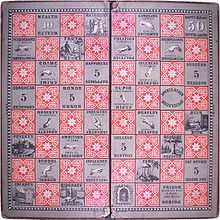
- Tabletop games
- Board games
- Tile-based games
- Turn-based games.html
- Abstract strategy games
- card games
- Connection games
- Mancala games
- Paper-and-pencil games
- Word games



| Players | 2 to 6 |
|---|---|
| Age range | 9 to adult |
| Playing time | 45 minutes (approx.) |
| Random chance | High (spinning a wheel, card-drawing, luck) |
| Skill(s) required | Counting, reading |
The Game of Life, also known simply as Life, is a board game originally created in 1860 by Milton Bradley, as The Checkered Game of Life. The Game of Life was America's first popular parlor game. The game simulates a person's travels through his or her life, from college to retirement, with jobs, marriage, and possible children along the way. Two to six players can participate in one game. Variations of the game accommodate eight to ten players.
The modern version was originally published 100 years later, in 1960. It was created by toy and game designer Reuben Klamer and was "heartily endorsed" by Art Linkletter. It is now part of the permanent collection of the Smithsonian's National Museum of American History. It later spawned a book, The Game of Life: How to Succeed in Real Life No Matter Where You Land (Running Press), by Lou Harry.
 The Checkered Game of Life board
The Checkered Game of Life boardThe game was originally created in 1860 by Milton Bradley as The Checkered Game of Life. This was the first game created by Bradley, a successful lithographer, whose major product until that time was a portrait of Abraham Lincoln with a clean-shaven face, which did not do well once the subject grew his famous beard. The game sold 45,000 copies by the end of its first year. Like many games from the 19th century, such as The Mansion of Happiness by S.B. Ives in 1843, it had a strong moral message.
Bradley's game did not include dice, instead using a teetotum, a six-sided top. (Dice were considered too similar to gambling.)
The game board was essentially a modified checkerboard. The object was to land on the "good" spaces and collect 100 points. A player could gain 50 points by reaching "Happy Old Age" in the upper-right corner, opposite "Infancy" where one began.
In 1960, the 100th anniversary of The Checkered Game of Life, the first modern version of The Game of Life, a collaboration between Reuben Klamer and Bill Markham, was introduced. The game was re-published many times over the years, including 1961, 1966, 1978, 1985, 1992, 2000, and 2005.
 The modern edition of The Game of Life
The modern edition of The Game of LifeThe modern game consists of a track on which players travel by spinning a small wheel (in the center of the board) with spaces numbered 1 through 10. The board also contains small mountains, buildings, and other three-dimensional objects. Playing pieces are small, colored, plastic automobiles which come in red, blue, white, yellow, orange, and green; each car has six holes in the top in which blue and/or pink "people pegs" are placed throughout the game as the player "gets married" and has or adopts "children". Some "early modern" editions have eight cars.
Each game also includes a setup for a bank, which includes play money (in denominations of $5,000, $10,000, $20,000, $50,000, and $100,000. The $500 bills were dropped in the 1980s, as were the $1,000 bills in 1992.), insurance policies (automobile, life, fire, and/or homeowners' insurance depending on the version), $20,000 promissory notes and stock certificates. Other tangibles vary with the game version.
The Game of Life, copyrighted by the Milton Bradley Company in 1963, had some differences from later versions. For example, once a player reached the Day of Reckoning, they had to choose between moving on to Millionaire Acres (if they had a lot of money), or trying to become a Millionaire Tycoon (if they had little or no money) with the risk of being sent to the "Poor Farm".
This version had Art Linkletter as the spokesman, included his likeness on the $100,000 bills (with his name displayed on the bills as "Arthur Linkletter Esq.") and a rousing endorsement from Linkletter on the cover of the box. It was advertised as a "Milton Bradley 100th Anniversary Game" and as "A Full 3-D Action Game."
Winning Moves currently markets a classic 1960's edition.
About halfway through the production of this version, many dollar values doubled. This description focuses on the later version with the larger dollar amounts. The late 1980s version also replaced the convertibles from earlier versions with minivans. Early 1960s-era convertibles were still used in the 1978 edition.
The "Revenge" squares were renamed "Sue for damages" in the 1978 edition.
The Game of Life was updated in 1991 to reward players for "good" behavior, such as recycling trash and helping the homeless.
An updated version of the game was released in 2005 with a few gameplay changes. The new Game of Life reduced the element of chance, although it is still primarily based on chance and still rewards players for taking risks.
In 2015, Lorraine Markham, widow of Bill Markham, sued Hasbro, claiming that her husband had invented the Game of Life and stated that she was owed $2 million or more in royalties.
Hasbro denied the claims and countersued, asking a federal judge to declare that it owns the rights to the game.